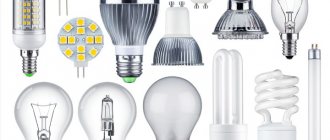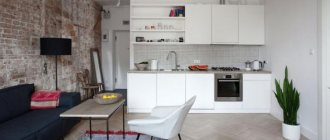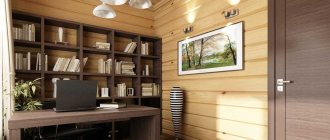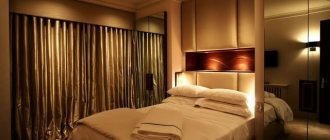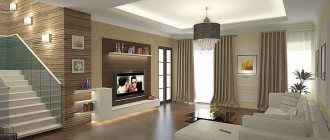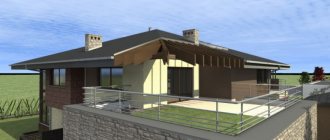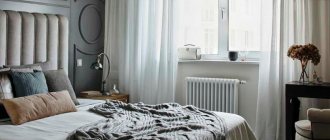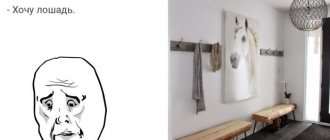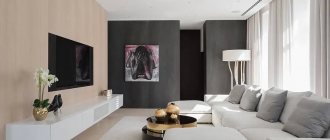Standards and requirements for indoor lighting
The basic requirements for home premises are set forth by SanPiN 2.2.1/2.1.1.1278-03, as well as SP 52.13330.2011. These documents establish the need to take measurements at floor level, and regulate the following parameters in lux:
- 150 Lux for kitchen and living areas in an apartment;
- 200 Lux for children's;
- 50 Lux for bathroom, toilet, corridor;
- 300 Lux for areas of the apartment with increased visual stress (offices, reading rooms, libraries);
- 400 – 500 Lux regarding the surfaces of work tables, places for doing handicrafts, and doing school assignments;
- 20 – 30 Lux for stairs, lobbies.
All data is calculated relative to a unit of area in the apartment. However, the above figures are only general recommendations regarding the rooms of the apartment. For each case directly, it is necessary to take into account a number of nuances on an individual basis.
Shadows from lamps: decorative effect or disadvantage
Designers classify decor with shadows as a type of creative lighting. To create fancy patterns on the wall, just choose lamps with perforated lampshades. Light streams will penetrate through the holes and softly scatter across the surface.
Another important aspect of a home shadow theater is the background where the reflection will fall. If it's dark, it won't have a stunning effect. Shadows look beautiful only on a light, monochromatic surface.
Let's look at the situation from the other side. The shadow of a low-lying pendant lamp falling on a table or bar counter is unlikely to delight. Therefore, when creating a scenario, consider suitable locations for the location of light and shadow sources.
Chandelier shadows as a decorative element
Nuances to consider
Since there is a huge variety of layouts for the living, working and auxiliary areas of apartments, and their owners want to satisfy personal needs, the lighting layout must take into account many nuances. Therefore, we will consider these features separately.
Calculation of the number of lamps and power standards
The number of lamps according to the power standard is determined from the ratio of power consumption and output luminous flux. Depending on the type of lighting lamps, each kilowatt of electricity consumed will produce a different luminous flux. The most effective today are LED lamps with a power of about 80 - 100 Lm/W.
For example, if you need to provide a luminous flux of 3000 lm for a hall of 15 m2, then this will require from 30 to 38 W of power. Let's take the maximum, then 4 LED lamps of 10 W each will suit you, the result will be 40 W of power with a flux of 3200 Lm.
On the other hand, not only the illumination needs to be checked, but also the strength of the wiring. So, the power consumption must correspond to the throughput of the cores.
It can be calculated or taken from the table:
Table: checking power by wire cross-section
If you have a cable with a cross-section of 1.5 mm2 to power a chandelier or spotlights, then when using 40 W of power, the wire allows you to turn on a load of 4.1 kW, so the selected devices more than meet the safety requirements.
Checking the quality of light
But it should be noted that in practice, the actual illumination directly on any surface may differ significantly from the previously obtained calculated data. This is determined by the type of chandelier shades, location in relation to furniture and interior elements, supply voltage, etc. That is why the quality of lighting is checked using a lux meter, which determines the result obtained in practice.
Colorful temperature
Color temperature for lighting devices refers to the level of radiant heat.
This parameter determines the type of lamp glow:
- Warm;
- Neutral;
- Cold.
Temperature is measured in Kelvin, for example, incandescent lamps produce a luminous flux closest to that of a bright sunny day, which is in the range of 2000 - 3000 K - this is the warm range. If you shift to 6000 - 8000 K, then it will be a cold glow, and between them there is neutral light, which can shift in one direction or another. The specific lighting temperature is selected depending on the purpose of the room in the apartment.
Figure 1: Glow color temperature
Color rendition of lamps
The luminous flux from lighting devices, hitting any surface, is reflected, as a result of which we perceive the basic parameters of the surrounding space. However, each color can have different shades if it is hit by a different wavelength, which is expressed by the color rendering index CRI; the optimal value is considered to be from 100 to 80. An example of the perception of the color of the same object is shown in the figure below:
Rice. 2: color rendering coefficient
Therefore, color rendering is selected as a derivative of the color temperature of lighting devices. It is selected depending on the room in the apartment and the activities performed in it.
Illumination
The illumination in the apartment may be uneven, especially since some lighting components will be decorative in nature. For example, in each room you can install the main lighting in the center of the room, which will set the main background when you are in the room. But in those target locations where it is necessary to increase the degree of illumination, additional stationary (soffits, sconces, strips) or portable lamps (table lamps or floor lamps) are installed.
To adjust the degree of illumination, step systems are widely used:
- chandeliers with multi-key switches;
- dimmers with dimmable lamp;
- several devices with the same or different lamps.
By combining different systems in one room, you can qualitatively change the lighting, add additional effects, etc.
Lamp location
Depending on the location where lighting devices are installed, it is generally accepted to install the chandelier in the center of the ceiling. However, with the introduction of spotlights, this trend began to be supplemented or completely eliminated. Therefore, today the principle of arrangement of lamps is not only functional, but also decorative. The figure below shows several interesting options, but if you wish, you can change them and adapt them to your own apartment.
Rice. 3. Example of luminaire placement diagrams
Additional sockets and switches
The wiring and lighting diagram of the apartment is drawn up in advance; at this stage, not only the possibility of switching on from any point is taken into account, but also the ability to navigate the mounted switches. Therefore, for each room it is necessary to delimit lighting zones from different switches or several keys, but at the same time, several switches are enough for you so as not to get confused in them.
When planning the connection of pass-through switches, take into account the double consumption of cable or wire. And when connecting an outlet and a switch, each of them must receive power from the distribution box; you should not connect the outlet from the lamp and vice versa.
Shadows
When planning the installation location of lighting devices in the apartment, be sure to take into account the shadows they cast. Otherwise, illiterate placement will lead to a significant reduction in the coverage area of the lamp, a decrease in its efficiency and will negate the power of the light bulb. Chandeliers, sconces and floor lamps that are at human level deserve special attention in this regard. Since the light flux from these devices intersects with a much larger number of interior items, the shadow from which can darken even the brightest room.
Decorative lighting in the floor and window sills
Rice. 4. Decorative floor lighting
Recently, decorative lighting has covered more and more details in the apartment:
- Ceilings;
- Floor;
- Furniture;
- Doorways;
- Windows and window sills.
Decorative lighting can be used both solely for decoration and as a night light, illuminating the space in the apartment or highlighting individual contours, which will also help to navigate in the dark. Spot lighting devices, LED strips, flexible neon or fiber optic cords are used as decorative lamps.
Why do you need a wiring diagram?
Without a clear plan for wiring around the apartment, not a single professional can work. When installation is carried out independently, the importance of the project increases even more. If everything is done correctly from the beginning, then you won’t have to spoil the finish to lay additional wires or connect extension cords that will lie under your feet. Here you need to follow several recommendations:
- All features of the operation of each room are thought out in advance. Only after this can you begin to draw up a project.
- The central element is the distribution panel; all wiring diverges from it.
Design begins with the distribution panel. - Automatic machines of appropriate power are responsible for security; the quantity is calculated separately for each apartment.
- Cables of the appropriate cross-section are laid from the machines. They are selected with a reserve to prevent overloads and overheating.
- All branches are made in special distribution boxes. Their location should also be noted.
- Reliable and safe switches and sockets are selected. The type of lighting, quantity and approximate location of equipment in each room are determined.
It is better to entrust the preparation of the project to professionals. Then it will be made in accordance with safety requirements.
Sources of light
Among lighting sources, there are two large groups - artificial light devices (lamps, LED strips, matrices, etc.), as well as natural light. The first source is not limited in time, but is costly from a financial point of view. The second is limited by the time of day, weather conditions and other factors, but allows you to save money. However, both categories require proper combination and placement relative to each other.
Natural light
Rice. 5. Natural lighting in the apartment
Despite the positive aspects of using natural light in an apartment, there is also a disturbing influence, which is determined by the position of the window relative to the cardinal points:
- The south window is considered the most powerful source, but at lunchtime the light can reach excessive levels, which will make staying in the room uncomfortable. Therefore, to regulate the intensity, blinds or roller blinds are installed on the windows.
- The northern one provides the minimum amount of illumination compared to the others, so the main thing is not to interfere with such windows; the sun almost never acts here in full force.
- Eastern - in intensity it is not much inferior to the southern ones, the difference exists only in the time of activity. Therefore, all measures here are identical.
- Western - can produce powerful lighting in the evening at sunset, so it is also advisable to close the window with a curtain.
Artificial lighting
In relation to natural light sources, artificial ones should be located in such a way that at dusk their flows do not overlap each other.
Rice. 6. Position of artificial lighting devices in relation to natural lighting
So, in the immediate vicinity of the window there is no point in installing a chandelier or a whole row of spotlights. Otherwise, the light that you could use for free will be completely extinguished by the main sources. If necessary, spot functional lighting can be installed near the window for a specific purpose.
Pass-through switch
A pass-through switch differs from a regular switch in the number of contacts. If a regular single-key one has 2 of them, then a pass-through one has 3 contacts. The incoming wire is connected to one, the wire going to the light source is connected to the other, the third goes to another similar switch.
The diagram shows the operating principle of pass-through switches
The two-gang switch has 4 contacts. The pictures clearly show how to control the light source using pass-through switches from 3 different places. On the block, special symbols show which contact corresponds to what. It is important not to confuse the connection order during installation.
Diagram for connecting the switches to each other: in the middle - a cross with 4 contacts for connecting the remaining switches to each other
Connection diagram for two-key pass-through switches
Various circuit options for connecting 3 pass-through switches
Main types of lamps used
Most often, four types of lamps are used to illuminate an apartment:
- incandescent - the cheapest, but also the least profitable, since they produce only 5 - 8 Lm/W and operate for about 1000 hours;
- halogen lamps - have slightly better characteristics 10 - 12 Lm/W and a service life of 2000 - 4000 hours, but are extremely capricious regarding the condition of the surface;
- luminescent - capable of delivering about 25 - 50 Lm/W and lasting about 10,000 - 20,000 hours, depending on conditions, but they contain mercury as part of the gas-discharge medium;
- LED are the most economical, since they are characterized by a flux of 90 - 120 Lm/W and can last from 25,000 to 50,000 hours, but they also have the highest cost.
One color temperature
In a good, complete, complete interior, the light environment should be monotonous.
This means that for lighting it is necessary to use lamps with the same color temperature.
A rare exception may be the case when you want to emphasize the texture of some materials, or highlight individual interior items.
Modern trends
Among modern techniques for lighting in an apartment, it is appropriate to use various lighting and decorative details as decoration or to enhance the design. These options will be the most interesting to consider.
Night lighting in the apartment
Rice. 7. Night lighting in the apartment
Night lighting is designed to create an atmosphere of comfort at a time when no active activities are taking place in the apartment. Such elements allow you to decorate dark corridors, the living room, create the effect of a starry sky in the bedroom, or highlight the contours of the ceiling pattern. In some cases, they act as a night light and can help household members orient themselves while moving to the bathroom or kitchen.
Motion sensors
Contactless switches have long occupied an important niche in lighting areas, retail facilities, and roadways, but now they are also used in apartments. For example, in the corridor or on the balcony, where the time spent is relatively short, and reaching the switch is not always convenient. The motion sensor turns on the light for a set period of time, after which the relay turns it off again.
Wireless lamps
Battery-powered lighting devices are installed in places where supplying a separate power supply line is impractical or in cases where the owner does not want to spoil the finishing work by gating walls and laying new wiring. Such lamps are not necessarily tied to any installation location; they can be fixed either permanently or moved from place to place.
Choice of installation method: open or hidden
After determining the layout of cable lines, the method of laying cables should be adopted. There are two ways to lay lines - hidden, open.
The first method is common when the finishing of premises is carried out with suspended structures and false panels (plasterboard, MDF). There is no need to make grooves (grooves) in the walls followed by putty. Hidden electrical wiring installed in an apartment has a number of significant advantages:
- maintaining the general appearance and integrity of the interior;
- less stringent requirements for cable installation conditions;
- increased tolerances to permitted currents.
It is not uncommon to see the option of open wiring. Wires are often placed in special plastic boxes attached to the decorative surfaces of the room. The open method of laying cables has the following advantages:
- possibility of installation after or during finishing work;
- faster installation;
- the ability to modernize the network by installing additional cables or dismantling them.
Currently, if the arrangement of the electrical network is an integral part of the general renovation of the premises, specialists often use a hidden method of laying conductors.
Examples of organizing lighting in different rooms of an apartment
Also, apartment lighting must take into account the location of certain lamps. Depending on the room, both the power and the method of transmitting the light flux are selected.
Living room, hall
Rice. 8. Lighting in the living room
The whole family gathers in the living room, and on significant dates it is also filled with guests. As a rule, this is the largest room in the apartment, so it is rational to install one central chandelier and several additional devices around the perimeter or in specific areas.
Bedroom
Rice. 9: bedroom lighting
The lighting in the bedroom should not be too powerful, so a chandelier is chosen with closed or diffuse shades so that the light from it predisposes to relaxation and sleep. You can hang a sconce near the bed or install a lamp on the bedside table or place a floor lamp. The bed itself can be equipped with decorative lighting along the contour; one or two spotlights can be placed near the dressing table.
Rice. 10. Illumination of the dressing table in the bedroom
Children's
In children's lighting, lighting is divided into several categories - general, not necessarily powerful, but covering the entire room, setting the background. For the playroom, soft diffused light is provided, providing comfortable play for the child. In the sleeping area, a night light or sconce will come in handy. A powerful lamp is installed near the desktop or directly on it for doing homework and other activities.
Rice. 11. Lighting in the nursery
Kitchen
Several types of lighting are also being developed for the kitchen:
- the common area directly in the center of the active area of the room, is selected so as to provide the dining table with maximum light;
- working - above the table or countertop, where all manipulations are performed, carried out by the most powerful and directed;
- near the stove or hob;
- decorative - around the perimeter of the ceiling or furniture.
Rice. 12. Lighting in the kitchen
Hallway
In the hallway there is no need to use overly powerful lighting devices or complex designer lamps. In this room, both you and your guests arrive for only a few minutes and do not perform any complex actions. Therefore, several spotlights of medium power will be enough. If the hallway is a long corridor, it can be supplemented with a sconce or a spot near the mirror.
Rice. 13. Hallway lighting
Bathroom and toilet
There is no point in installing powerful lighting fixtures in the bathroom, so they use several spotlights around the perimeter of the ceiling. LED lighting is used to highlight any details. As a rule, an adjustable lighting device is located near the mirror for convenience of shaving, applying makeup, etc.
Rice. 14. Bathroom lighting
Temporary shelter with three sockets
This design is inconvenient because:
- firstly, you need to buy two different products
- secondly, there is only one outlet
As practice shows, even two sockets are often not enough. Therefore, it is better to use triple blocks of carrying sockets, which already come with a built-in switch inside the case.
Naturally, the unit will have to be disassembled and the wire connections re-soldered according to the diagram below.
Just be careful when assembling, the switch should break the phase conductor.
Do you want everything to be grounded? Please! Instead of a three-wire cable running down to the carrier, use a four-wire cable.
The fourth vein will be “earth”. True, this land should also be present under the ceiling.
It is already possible to connect several instruments to this design at the same time. At the same time, do not forget that all such carriers are designed for a load of no more than 10-16A.
Even more modern lighting ideas in the photo
Here we will look at some interesting ideas for lighting an apartment.
Design properties of decorative light bulbs in the interior
Multi-colored lighting allows you to decorate absolutely any interior, even if it is already extremely luxurious, and also helps to create a certain atmosphere in the room, using devices with various dimensions and style characteristics. If decorative light is placed correctly, it can even be used as the main light.
Decorative lighting in the elements of a wooden panel near the sofa in a modern living room
The main design tasks of decorative lighting include:
- Creating an emphasis on a specific area or surface: on the architectural parts of the room, a piece of furniture or a decorative element; You can highlight graceful forms of sculptures or statues, stairs, fireplaces, paintings, mirrors, aquariums, fountains, headboards, bedside tables, plants, multi-level ceilings, doors, etc.
- Visually expanding the space or changing its shape is possible with the help of any lighting device, but it is better to use an LED strip, which is suitable for use in any room; it is practically invisible, and while playing from its light you can change the height of the ceilings, make the size of the rooms more proportional, etc.
- The embodiment of optical illusion: plain or colored lighting can change the shape of furniture, paraphernalia and finishing components; it can be used, for example, to lighten monumental structures or heavy large objects (especially antique chests of drawers, sideboards, trellises, wardrobes made of solid wood), and it is also suitable for creating the effect of a floating bed, which seems to be in zero gravity.
Decorative lighting to accent the headboard in a modern bedroom.
Look at the project : Interior of the Shulgino country house.
An alternative to a chandelier - pendants
Pendant lamps resemble chandeliers, but, unlike them, they can emit not only diffused, but also directional light. With their help, space is perfectly zoned, and the ability to adjust the height of the suspension is very convenient. Everything that was said above about chandeliers applies here too. Spots can be used in pendant lamps, which means the beam of light can be directed in any direction. Choose lamps with geometric shapes or floral designs, avant-garde-futuristic, classic or retro, any of these, in accordance with your preferences - and you definitely can’t go wrong.
Always fashionable chandeliers
Of course, we start with the chandelier, as the main character in lighting. And yet its main function remains decorative. When choosing a chandelier, we are primarily interested in it not as a lighting fixture, but as part of the interior. What chandeliers are fashionable this season?
- Geometric shapes. Chandeliers in the shape of triangles, squares, cubes, and polygons are now at the peak of popularity. They will make the interior innovative and dynamic, especially if they echo the geometric patterns on the walls. So, strict geometry holds its position in the interior.
- Cascading chandeliers - especially if you have a large room or combined rooms, a cascading model will add lightness to the interior.
- The popularity of spherical shapes has already been mentioned above. Spherical chandeliers are the highlight of a modern interior.
- Well, many ideas still prompt designers to turn to retro motifs from the 50s-70s of the last century.
Luxurious classic crystal chandeliers with pendants and an abundance of decorations today, alas, are no longer relevant. Plastic chandeliers also look hopelessly anachronistic.
